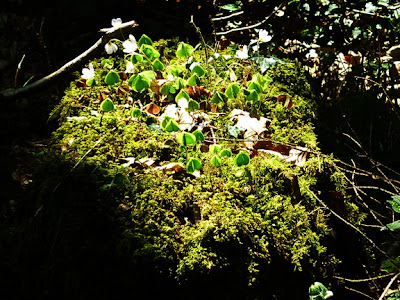For the last few weeks, Marcia and I
have been pottering around as she has been looking for and listening
to the people who will, I have no doubt, dominate our household for
the next few months during which we shall both get to know them
better than our relatives and closest friends. What an odd business this is.
 |
| The tall people in the middle are antirrhinum. Around them are the white flowers of Little Mouse Ear and bottom left a few bluebells and there are a lot of other species in there too. |
 |
| The yellow flowers belong to the white dead nettle. Bottom right the wild garlic (we call them ransoms). They smell wonderful on a hot day and, yes, you can use them in cooking. |
There is a universal need to connect to nature which is why natural history programmes are so popular. I watch some of these too (usually in the depths of winter) but given the option of sitting in front of a television and watching some exotic beast from some foreign country or just pottering down one of our lanes I would always choose the latter. Indeed, I imagine myself in old age in a powered wheelchair doing so to the bitter end.
 |
| Ramsons again. |
 |
| Stonecrop, a sedum that (as the name suggests) loves to live in stony places but there, just alongside, is a group of bluebells which don't. Both seem to be doing quite well. |
So yesterday I set off with my simplest camera – a delightful Panasonic Lumix – and I took a series of photographs from the car just to prove the point and to share some of the delights with you. Some of the plants shown here are already passing over – now the verges and hedges will start to take on their summer coats – the snowdrops have gone but we still have some winter aconite, primroses and celendines (but I have already shared them with you in earlier blogs). Yes, there will be much to see and much to enjoy but it will be autumn before the lanes are once again quite simply magical.
 |
| Almost certainly cow parsley or a close relative. This family (after which the umbrella gets its name) will dominate the verges for the rest of the summer. |
I should add that one of the constraints of sticking to taking photographs from the car is that you only have those images available when it comes to identification. I have done the best I can but some may well be wrongly named. The other problem is that you tend to hold up the traffic: sorry to all those who sat behind me, patiently waiting until (with a jolt) I realised they were there.
Of course he's called Churchill. Well, he had to be didn't it? (For those who do not live in the UK, this is the spit image of a dog who is used to advertise an insurance company which trades under the name of Churchill).


















































